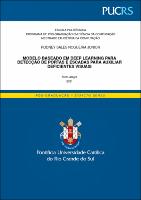| Share record |


|
Please use this identifier to cite or link to this item:
https://tede2.pucrs.br/tede2/handle/tede/9828| Document type: | Dissertação |
| Title: | Modelo baseado em deep learning para detecção de portas e escadas para auxiliar deficientes visuais |
| Other Titles: | A deep learning based model for the detection of doors and stairs to aid the visually impaired |
| Author: | Nogueira Junior, Rodney Sales  |
| Advisor: | Manssour, Isabel Harb |
| Abstract (native): | Devido ao grande numero de pessoas com deficiência visual no mundo, e com o avanço tecnológico, os interesses em pesquisa e desenvolvimento de diferentes técnicas de apoio a mobilidade dessas pessoas aumentou. Nesse contexto a detecção de portas e escadas é um tópico de pesquisa importante, pois provê informações que podem auxiliar a mobilidade dessas pessoas. Este trabalho apresenta um modelo para auxílio a navegação em ambientes internos para deficientes visuais. Através de um estudo aprofundado da literatura, foram encontrados trabalhos que utilizam de técnicas de visão computacional para identificar corredores, obstáculos, portas e escadas. Entretanto, poucos utilizam os recentes avanços em visão computacional e redes neurais convolucionais para esse objetivo. Desta forma, o presente modelo engloba um experimento sobre as redes neurais convolucionais para o reconhecimento e detecção de portas e escadas. Usando o método YOLO, apresentamos um modelo que não só detecta diferentes tipos de portas, como também também é capaz de diferenciar escadas ascendentes e descendentes, com taxas de FPS próximas a 30, e mAP acima de 90%. |
| Abstract (english): | Due to a large number of visually impaired persons in the world, and with the advance of technology, the research interest in the development of different approaches to support the mobility of these persons has increased. In this context, the detection of doorsand stairs is an important research topic because it provides useful information that can aid in the mobility of these persons. In this work, we present a model to aid the visually impaired navigation in indoor environments. We found approaches that use computer vision techniques to identify corridors, obstacles, stairs, and doors through a literature review. However, few of them use recent techniques in computer vision and convolutional neural networks in their solutions. Thus, the presented model includes an experiment on convolutional neural networks to recognize and detect doors and stairs. Using the YOLO method, we present a model that detects not only different kinds of doors but also is capable of differentiating ascending and descending stairs, with FPS rates close to 30 and mAP above 90%. |
| Keywords: | Visão Computacional Redes Neurais Convolucionais Ambientes Internos Deficientes Visuais Computer Vision Convolutional Neural Networks Indoor Environments Visually Impaired |
| CNPQ Knowledge Areas: | CIENCIA DA COMPUTACAO::TEORIA DA COMPUTACAO |
| Language: | por |
| Country: | Brasil |
| Publisher: | Pontifícia Universidade Católica do Rio Grande do Sul |
| Institution Acronym: | PUCRS |
| Department: | Escola Politécnica |
| Program: | Programa de Pós-Graduação em Ciência da Computação |
| Access type: | Acesso Aberto |
| Fulltext access restriction: | Trabalho não apresenta restrição para publicação |
| URI: | http://tede2.pucrs.br/tede2/handle/tede/9828 |
| Issue Date: | 29-Aug-2018 |
| Appears in Collections: | Programa de Pós-Graduação em Ciência da Computação |
Files in This Item:
| File | Description | Size | Format | |
|---|---|---|---|---|
| RODNEY SALES NOGUEIRA JR_DIS.pdf | RODNEY_SALES_NOGUEIRA_JUNIOR_DIS | 2.42 MB | Adobe PDF |  Download/Open Preview |
Items in DSpace are protected by copyright, with all rights reserved, unless otherwise indicated.




